|
|
Adventure
|
Name:
|
Adventure |
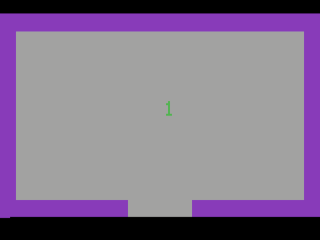 |
| Company: | Atari | |
|
Model #:
|
CX-2613 | |
|
Programmer:
|
Warren Robinett |
|
| Year: | 1980 | |
|
Released?
|
Yes |
|
|
Notes:
|
Warren started development on a sequel called Elf
Adventure that was never finished |
A game that needs no introduction, Adventure has long been one
of the most popular games on the 2600. Introduced in 1980
as one of Atari's first 4K games, Adventure was both a simple
yet decidedly complex game. Players could pick it up and
blindly chase after the chalice with only a faint understanding
of the rules, or they could learn the intricacies of the game
and use several different strategies to increase their chances
of winning. Part of Adventures enduring popularity is due
to its simplistic graphics where the player is a simple square
and the dragons look like mutated ducks which have a long
lasting charm. Also of note is the randomization mode
(variation 3) which hides the game objects in different areas
each time the game is played resulting in a brand new game each
time. This helps keep the game fresh even after players
have mastered the mechanics.
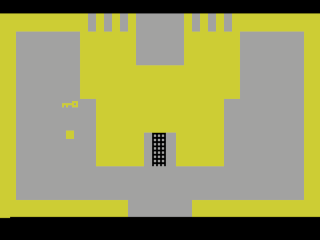
In Adventure you play the role of an adventurer who just happens to look like a square (really!) who must navigate the maze-like kingdom of Adventure in search of the enchanted chalice (stolen by an evil wizard of course) and bring it back to the gold castle. The wizard has created three evil ducks dragons (Yorgle, Grundle, and Rhindle) who will attempt to thwart your efforts. If any of these dragons find you they will attempt to eat and swallow you whole! Thankfully the player can find the arrow sword which he can use to kill the dragons by touching them (be careful as they can still eat you even if you're armed with the sword). Also roaming the kingdom is the bat. The bat isn't good or evil, the bat is simply an agent of chaos. The bat will pick up and drop objects at random and 'trade' them for whatever you're currently holding. This can either be good (the bat swaps something locked in a castle with something you no longer need), or bad (the bad decides to swap the chalice you're carrying for a key).
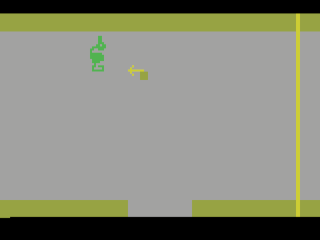
Bats? Dragons? What next, you ask. How about a
magnet? No, not an evil magnet, just a plain ordinary magnet
(well it might be slightly evil, we'll have to check on that and
get back to you). The magnet is a handy tool that will allow
the player to attract objects if they're close enough. The
magnet is mostly used to grab objects that are either stuck in
walls or are just out of reach. Different objects have
different levels of attraction (the chalice is the lowest), so
don't think you're going to quickly snag the chalice by running
around with the magnet (we're on to you!). In addition to
the magnet the player can also find a bridge. This bridge
will allow the player to move through walls when strategically
placed (don't ask too many questions, it's magic alright?), but be
careful not to accidentally trap yourself in an area with
exit. In addition to the magnet and bridge, you may also
find various colored keys scattered around the kingdom. Each
castle is locked and can only be opened by the appropriate colored
key (black, gold, white, etc.). Due to an error in the game
code, there's a small chance that the yellow key will be locked
inside the yellow castle in the random game variation (3).
If this happens the game will be unwinnable. Incidentally
the bridge cannot be used to bypass locked castle gates, so no
cheating!

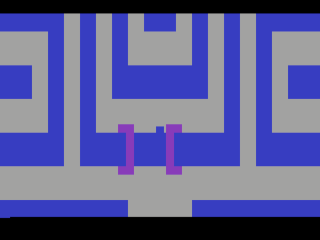
Adventure is interesting in that it has no score, no life counter, and no timer. The only winning condition is finding and returning the chalice, and the player can take all the time in the world to do that. Although there are no lives, if the player is eaten by a dragon the game is considered over (you'll be trapped in the dragon's stomach). At this point you can press the reset button to continue the game, sort of. When reset any slain dragons will be resurrected but all the items in the kingdom will remain where they are so you can continue where you left off (the manual refers to this as reincarnation).

Adventure has three different variations that control the scope of the game. Variation one is the sort of a stripped down version of the game consisting of only the gold and black castles, catacombs (mazes), and only two of the three dragons. The sword is always found in the gold castle (where you start) and the chalice is always in the black castle, making this a good variation to start with to help get your barrings on how the game works. Variation two is the full game with all three dragons, all three castles and catacombs. Variation three is the same as variation two, but the dragons and items are placed randomly in the kingdom making it different each time you play. In addition to the three variations, the two difficulty switches can be used to adjust the difficulty. The left switch controls whether or not the dragon will 'hesitate' before eating you (giving you a split second to get away). The right switch controls whether or not the dragons are afraid of the sword or not.
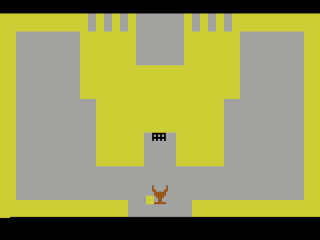
I'd be remiss in my write up if I didn't mention the famous Adventure easter egg. While many people think that Adventure was the first game to have an easter egg due to it being the most widely publicized and being mentioned in books and movies like Ready Player One, this is actually not true. The honor of being the first easter egg is a matter of debate, but that honor either belongs to Spitfire on the Channel F (although the easter egg could not be triggered on the released console) or Atari's arcade game Starship-1 both of which were released in 1977. Adventure's easter egg can be triggered by finding theinvisible dot hidden in a walled off area of the black castle maze (variations 2 and 3) and two other items and bring them to the room then walk through the wall. When done correctly you'll be in a room with the words Created by Warren Robinett running down the center. An alternative way of triggering the easter egg is to bring almost every item in the game (including dead dragons dropped by the bat) to the screen to the right of the gold castle and walk through the wall when everything is flickering (this might take a few tries). This works by exploiting a bug caused by the collision detection going wonky when too many items are on the screen at once.
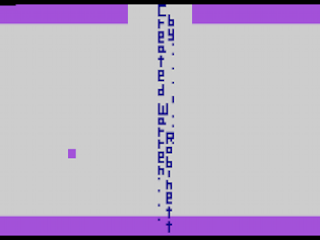
Warren has stated that Adventure was inspired by the old text adventure game Adventure. Warren wanted to somehow do a version of Adventure for the Atari 2600, but his manager at the time told him that not only was this impossible, but that only upper management should be coming up with game ideas. Warren decided to work on his idea anyway and came up with the idea of creating the world of Adventure in a simplistic graphical form that the 2600 could handle. While Adventure on the 2600 doesn't really resemble the Adventure text adventure, the spirit of the game is there and makes for a fine game in its own right. Warren's Adventure code would later be used to create Superman, another 2600 game with a cult following. Warren was originally assigned to do the game but decided to leave Atari so the game was programmed by John Dunn (of Snark fame) instead. Interestingly the only known prototype for Snark has graphics from an early WIP version of Adventure in it as they were in development at the same time and probably reused EPROMs. These graphics include a roadrunner, which was the original idea for the bat.
| Version | Cart Text | Description |
| ?/??/80 | Adven | Final version |
